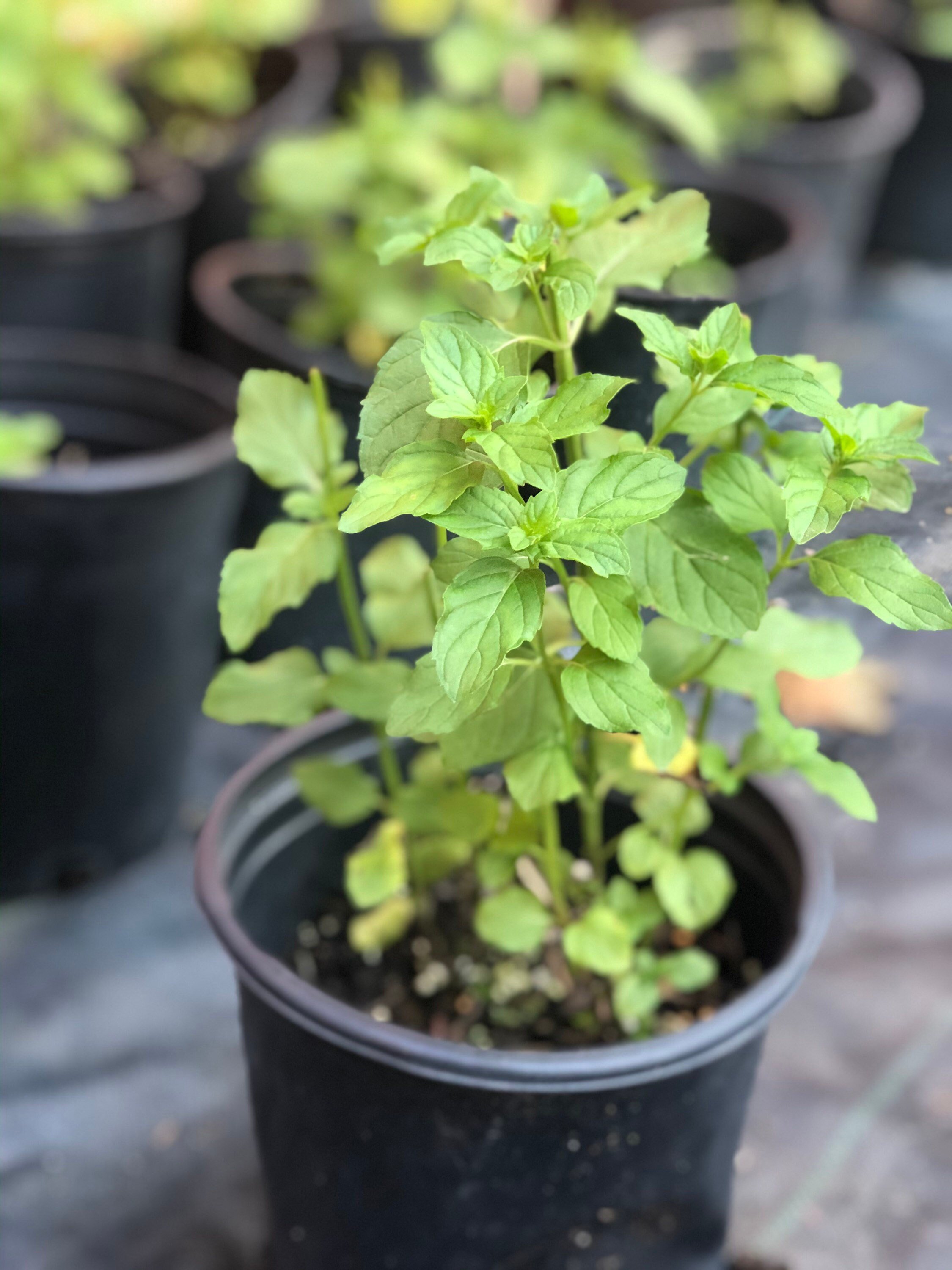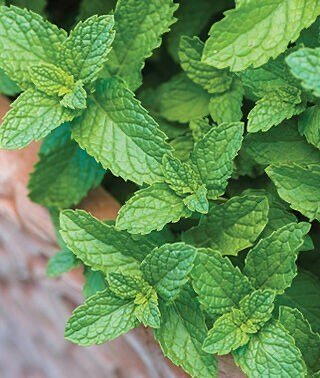 Image 1 of 3
Image 1 of 3

 Image 2 of 3
Image 2 of 3

 Image 3 of 3
Image 3 of 3




Organic Spearmint Herb Fully Rooted 1 Gallon Live Plant, Mentha Spicata
$9.99
sold out
Spearmint is a great plant that will grow vigorously, and tastes great! Very easy to grow plant that will do great in shade or sun. Great for upset stomachs, as well as, may help memory.
This plant ships as a 1 gallon plant with pot
Spearmint grows best in zones 4-11. It is suited to sandy, loamy, or clay soils that are well drained and not too dry, with a pH between 6.0-7.5. Spearmint should be grown in full sunlight in order to produce more essential oils, but can also be grown in partial shade. The plant should be spaced 3 feet apart, as it grows 1-1.5 feet tall and 3 feet wide. Spearmint is in bloom from August to September. The plant needs frequent watering so that the soil is always moist. The plant should be placed in a pot before placing it in the ground because spearmint has very invasive roots and stems, and easily spreads. However spearmint cuttings can be propagated in water, as their roots will grow in 1-2 weeks and can be replanted elsewhere (3). It can be a good companion plant to cabbages and tomatoes because it wards of pests and insects. This helps lower the need for pesticides.
Culinary and Medicinal Uses
Spearmint leaves are often used in different culinary dishes and drinks as a garnish. It can also be used to make teas. The menthol found in spearmint has been found to increase the production of bile, which promotes a healthy digestive system. It can also be used as a moth repellant (3). Spearmint is also used to mask tastes from other herbs without diminishing the effectiveness. For example, in Mexican cultures, spearmint is added to tea with bitter rue, as a treatment for menstrual cramps, to improve flavor. (4)
Significance to Cultural Communities
Spearmint is native to southern and eastern Europe. The stems and essential oil from spearmint is used in folk medicine to treat cancer. In Mexico, mint is used in Albondigas (2). Spearmint is used in many Mexican herbal remedies and is regarded as gentle and comforting. In the Middle East, mint tea is often served to guests to welcome them. In this region, mint is seen as a symbol of hospitality, which is why serving a cup of mint tea with friends, family, and guests is somewhat like a daily ritual. In Morocco, making mint tea is actually seen as a job for the men, who consider it an art form; they use special tea pots and pouring techniques.
This plant ships as a 1 gallon plant with pot
Spearmint grows best in zones 4-11. It is suited to sandy, loamy, or clay soils that are well drained and not too dry, with a pH between 6.0-7.5. Spearmint should be grown in full sunlight in order to produce more essential oils, but can also be grown in partial shade. The plant should be spaced 3 feet apart, as it grows 1-1.5 feet tall and 3 feet wide. Spearmint is in bloom from August to September. The plant needs frequent watering so that the soil is always moist. The plant should be placed in a pot before placing it in the ground because spearmint has very invasive roots and stems, and easily spreads. However spearmint cuttings can be propagated in water, as their roots will grow in 1-2 weeks and can be replanted elsewhere (3). It can be a good companion plant to cabbages and tomatoes because it wards of pests and insects. This helps lower the need for pesticides.
Culinary and Medicinal Uses
Spearmint leaves are often used in different culinary dishes and drinks as a garnish. It can also be used to make teas. The menthol found in spearmint has been found to increase the production of bile, which promotes a healthy digestive system. It can also be used as a moth repellant (3). Spearmint is also used to mask tastes from other herbs without diminishing the effectiveness. For example, in Mexican cultures, spearmint is added to tea with bitter rue, as a treatment for menstrual cramps, to improve flavor. (4)
Significance to Cultural Communities
Spearmint is native to southern and eastern Europe. The stems and essential oil from spearmint is used in folk medicine to treat cancer. In Mexico, mint is used in Albondigas (2). Spearmint is used in many Mexican herbal remedies and is regarded as gentle and comforting. In the Middle East, mint tea is often served to guests to welcome them. In this region, mint is seen as a symbol of hospitality, which is why serving a cup of mint tea with friends, family, and guests is somewhat like a daily ritual. In Morocco, making mint tea is actually seen as a job for the men, who consider it an art form; they use special tea pots and pouring techniques.
Spearmint is a great plant that will grow vigorously, and tastes great! Very easy to grow plant that will do great in shade or sun. Great for upset stomachs, as well as, may help memory.
This plant ships as a 1 gallon plant with pot
Spearmint grows best in zones 4-11. It is suited to sandy, loamy, or clay soils that are well drained and not too dry, with a pH between 6.0-7.5. Spearmint should be grown in full sunlight in order to produce more essential oils, but can also be grown in partial shade. The plant should be spaced 3 feet apart, as it grows 1-1.5 feet tall and 3 feet wide. Spearmint is in bloom from August to September. The plant needs frequent watering so that the soil is always moist. The plant should be placed in a pot before placing it in the ground because spearmint has very invasive roots and stems, and easily spreads. However spearmint cuttings can be propagated in water, as their roots will grow in 1-2 weeks and can be replanted elsewhere (3). It can be a good companion plant to cabbages and tomatoes because it wards of pests and insects. This helps lower the need for pesticides.
Culinary and Medicinal Uses
Spearmint leaves are often used in different culinary dishes and drinks as a garnish. It can also be used to make teas. The menthol found in spearmint has been found to increase the production of bile, which promotes a healthy digestive system. It can also be used as a moth repellant (3). Spearmint is also used to mask tastes from other herbs without diminishing the effectiveness. For example, in Mexican cultures, spearmint is added to tea with bitter rue, as a treatment for menstrual cramps, to improve flavor. (4)
Significance to Cultural Communities
Spearmint is native to southern and eastern Europe. The stems and essential oil from spearmint is used in folk medicine to treat cancer. In Mexico, mint is used in Albondigas (2). Spearmint is used in many Mexican herbal remedies and is regarded as gentle and comforting. In the Middle East, mint tea is often served to guests to welcome them. In this region, mint is seen as a symbol of hospitality, which is why serving a cup of mint tea with friends, family, and guests is somewhat like a daily ritual. In Morocco, making mint tea is actually seen as a job for the men, who consider it an art form; they use special tea pots and pouring techniques.
This plant ships as a 1 gallon plant with pot
Spearmint grows best in zones 4-11. It is suited to sandy, loamy, or clay soils that are well drained and not too dry, with a pH between 6.0-7.5. Spearmint should be grown in full sunlight in order to produce more essential oils, but can also be grown in partial shade. The plant should be spaced 3 feet apart, as it grows 1-1.5 feet tall and 3 feet wide. Spearmint is in bloom from August to September. The plant needs frequent watering so that the soil is always moist. The plant should be placed in a pot before placing it in the ground because spearmint has very invasive roots and stems, and easily spreads. However spearmint cuttings can be propagated in water, as their roots will grow in 1-2 weeks and can be replanted elsewhere (3). It can be a good companion plant to cabbages and tomatoes because it wards of pests and insects. This helps lower the need for pesticides.
Culinary and Medicinal Uses
Spearmint leaves are often used in different culinary dishes and drinks as a garnish. It can also be used to make teas. The menthol found in spearmint has been found to increase the production of bile, which promotes a healthy digestive system. It can also be used as a moth repellant (3). Spearmint is also used to mask tastes from other herbs without diminishing the effectiveness. For example, in Mexican cultures, spearmint is added to tea with bitter rue, as a treatment for menstrual cramps, to improve flavor. (4)
Significance to Cultural Communities
Spearmint is native to southern and eastern Europe. The stems and essential oil from spearmint is used in folk medicine to treat cancer. In Mexico, mint is used in Albondigas (2). Spearmint is used in many Mexican herbal remedies and is regarded as gentle and comforting. In the Middle East, mint tea is often served to guests to welcome them. In this region, mint is seen as a symbol of hospitality, which is why serving a cup of mint tea with friends, family, and guests is somewhat like a daily ritual. In Morocco, making mint tea is actually seen as a job for the men, who consider it an art form; they use special tea pots and pouring techniques.